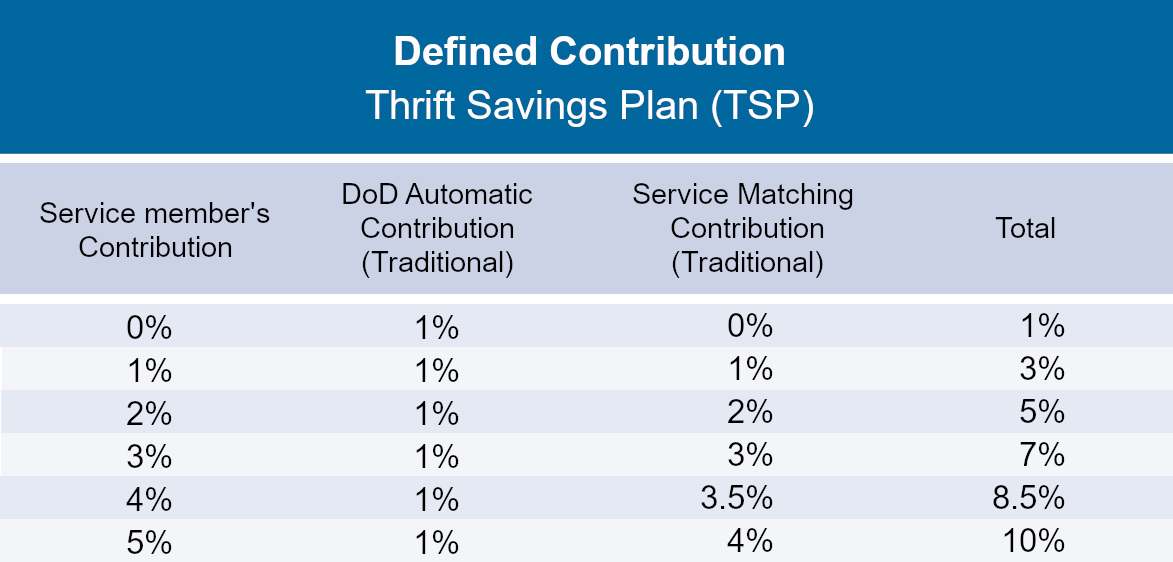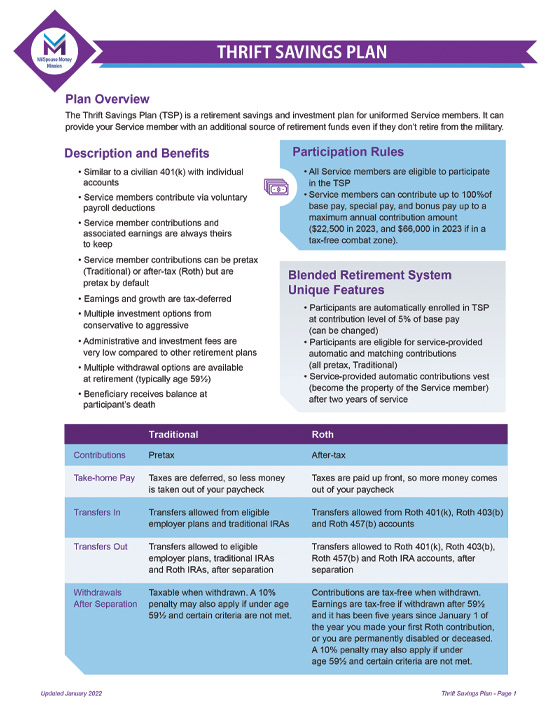Get Started
Congratulations to your spouse on completing two years of service. This marks an important milestone if they fall under the Blended Retirement System (BRS).
Vesting in the Thrift Savings Plan (TSP)
Financial Planning
The TSP is a type of retirement savings plan open to federal employees and members of the uniformed services. It offers you the opportunity save and invest for retirement.
Financial Planning Considerations
Resources
Learn more about the resources available within the military community. There are sources of support and information available online and at each installation.
Know What's Available
1
Getting Started
The Thrift Savings Plan (TSP) is one aspect of your Service member’s retirement plan that can help your family save in a tax-advantaged way. The TSP is available whether your spouse falls under the Legacy or the Blended Retirement System (BRS). However, this section on TSP Vesting only applies to those in the BRS.
If your spouse is enrolled in the BRS, they are eligible to contribute to the TSP and receive matching contributions from their service.
Whether they decide to contribute or not, they will still receive an automatic 1% contribution. If your Service member does contribute, not only will they receive the 1% automatic contribution, but their service will match the level of their contribution up to 4%. The chart below illustrates how the different contributions can add up.

As you can see from the chart, the more money your Service member puts in, the greater the match, up to 5%. This is “free money” from the military, but there are rules that govern contributions.
First, your Service member must stay in the military for two years before the service additions truly become theirs. This is called “vesting.” The Service member's contributions are always theirs, but if they leave before being vested, the automatic and matching contributions from the service are forfeited.
Second, for 2023 the IRS limits participant contributions to $22,500. Service members over the age of 50, however, can contribute an additional $7,500 as a “catch-up” contribution.
For more information on the TSP, review this handout below.
2
Financial Planning Considerations
Now that you know how the military encourages and rewards saving for retirement, let’s discuss how to take full advantage of this opportunity.
Step 1
Take control of your budget as a couple. If you do not already have a budget in place, set one up and follow it. Click here to visit our resource, Money Ready - Create a Budget.
Step 2
Cover your expenses and make sure you are also saving for the future. Saving for retirement should be a line item in your budget. Experts suggest a goal to save at least 10 to 15% of your pretax income for retirement. The TSP is one of the easiest and most effective ways to save. The more your Service member can save early in their career, the greater the match and the more time the investments will have to grow.
Remember that funds in the TSP are meant to be used for retirement. There is a 10% penalty on withdrawing funds before the age of 59½. Also, distributions from a traditional TSP are taxable.
Step 3
Spread your contributions out over the entire year to take full advantage of the match. If your Service member contributes up to the IRS limit before the end of the year, the service is not able to match any more contributions until the next year. Decide what percentage of base pay your family can consistently contribute each month. Make it a goal to contribute at least 5% to take full advantage of the match.
Step 4
Manage your account. Your Service member will enroll in the TSP through their service payroll office or electronic system. Then, they will set up an online account to manage contributions, allocation and view performance.
The TSP has several different index fund options that are designed to mimic certain areas of the stock market. These include U.S. stock, fixed income, government securities, and international stock. Click here for more information on the allocation options.
Age-based funds, called Lifecycle funds, are also available. This page on the TSP portal will help you determine your personal risk tolerance and retirement needs to guide your allocation strategy.
Step 5
Choose your beneficiaries. The TSP is the type of asset that is passed on by beneficiary designation. Your Service member will decide whom to leave the TSP to in the event of their death. Circumstances and wishes may change over time. It is a good idea to review beneficiary designations on an annual basis and when you’ve gone through a life change like marriage, birth or adoption of a child, or divorce. Submit form TSP-3 to make changes. If a beneficiary is not designated, the TSP will be distributed by statutory order of precedence. Click here for more information.
As a military spouse, you should be knowledgeable about the TSP, so you can better help your Service member make wise decisions. Think about how the TSP can help your family achieve its goals and be prepared for retirement. Visit your personal financial counselor at your installation if you have additional questions. To locate a counselor, visit https://installations.militaryonesource.mil/.
In this video, Shaun, an Air Force spouse, explains why it is so important to begin saving and investing as soon as possible. Hint: It has to do with compound interest!
3
Resources
This is your go-to source for information on the TSP. The login portal for online access is here as well.
Staying on track with a budget is the best way to know how much you can save for retirement. Remember to update your budget and savings rate when you get promoted or get a raise.
View this short video for a quick explanation of TSP vesting.











